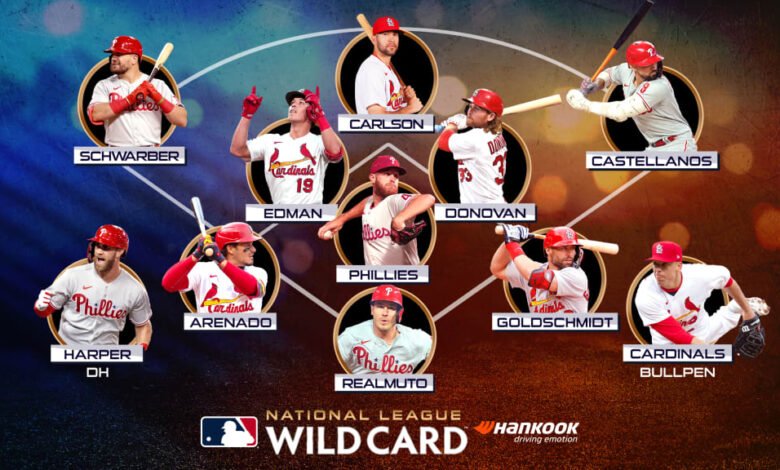Analyzing the Phillies vs St. Louis Cardinals Match Player Stats

Introduction to the Phillies vs St. Louis Cardinals Match
The Phillies vs St. Louis Cardinals Match Player Stats represent two storied franchises in Major League Baseball (MLB), with a rivalry that has evolved over decades. Both teams have rich histories, marked by numerous playoff appearances and championship victories. This competitive dynamic adds an extra layer of excitement whenever they meet on the field, capturing the attention of fans and analysts alike. Analyzing the Phillies vs St. Louis Cardinals match player stats provides invaluable insights into each team’s strengths and weaknesses, influencing predictions and strategies.
The significance of this rivalry extends beyond mere statistics; it embodies the spirit of competition that drives baseball in America. Historical highlights, such as the memorable playoff encounters and legendary performances by key players, continue to fuel the rivalry. Each confrontation is crucial, as the outcome impacts not only standings but also the psychological landscape of both clubs. As these teams compete for dominance in their division, the importance of understanding player performance cannot be overstated.
Player statistics in this matchup serve as a window into the effectiveness and strategies employed by both the Phillies and the Cardinals. As we delve deeper into the specifics of the players participating in these games, it becomes clear how individual performances—be it pitching depths, batting averages, or defensive capabilities—can sway the results of the match. In forthcoming sections, we will dissect relevant player stats to reveal patterns and trends that underscore the ongoing battle between these two iconic teams.
By examining the relevant player stats in the context of the Phillies vs St. Louis Cardinals matches, we pave the way for a comprehensive analysis that illuminates not just the numbers but the narratives behind them. Ultimately, understanding these statistics enhances our appreciation of the game and the fierce rivalry that continues to unfold on the diamond.
Historical Context: Phillies and Cardinals Rivalry
The rivalry between the Philadelphia Phillies and the St. Louis Cardinals is one that has developed over more than a century, marked by competitive spirit, dramatic games, and significant player achievements. This intense matchup has produced numerous memorable moments, making it a focal point in Major League Baseball history. The first meeting between these two teams took place in 1882, establishing the groundwork for what would become a storied competition. As both franchises evolved, they not only aimed for divisional supremacy but also encountered each other frequently in postseason play.
Throughout their history, the matchups between the Phillies and Cardinals have been notable for their high stakes and the implications they have had on league standings. For instance, one of the most remarkable events occurred in the 1980 National League Championship Series, where the Phillies triumphed, showcasing skillful play from key players that led to their championship that year. Historical player stats from that series remain a topic of discussion, reflecting the intensity of the rivalry and the significance of those games in shaping both franchises’ identities.
Key Players to Watch in the Match
As the Phillies prepare to face the St. Louis Cardinals, the focus will be on standout players from both teams, particularly those whose performances might influence the match’s outcome. The Phillies’ roster features dynamic hitters and talented pitchers who have shown consistent form in recent games. One player to keep an eye on is Bryce Harper, whose batting average and on-base percentage highlight his critical role in driving runs. Harper’s ability to not only hit for power but also maintain discipline at the plate makes him a vital asset for the Phillies.
On the pitching side for the Phillies, Zack Wheeler has emerged as the ace of the staff. His strikeout rate is among the highest in the league, and he has been instrumental in delivering strong performances in high-pressure situations. Wheeler’s ability to dominate opposing lineups can be a game-changer, particularly against the Cardinals’ formidable hitters. His recent form indicates that he is capable of providing a significant advantage in this matchup.
Turning to the St. Louis Cardinals, Paul Goldschmidt’s presence cannot be overlooked. The first baseman has consistently ranked among the league leaders in various offensive metrics, making him an integral component of the Cardinals’ batting order. His experience and clutch hitting ability often provide the necessary spark, particularly during tight match situations. Furthermore, St. Louis will also rely heavily on Nolan Arenado, whose defensive expertise and offensive contributions can impact the game both in the field and at the plate.
As the Phillies vs. St. Louis Cardinals match unfolds, these key players’ performances will be scrutinized closely. Their respective statistics and roles within their teams indicate a promising contest ahead, potentially swaying the match’s result based on their contributions. Keeping an eye on Harper, Wheeler, Goldschmidt, and Arenado may well reveal trends that could define the game.
Batting Statistics Analysis
In the context of the Phillies vs St. Louis Cardinals match, an insightful analysis of batting statistics is essential to gauge player performance and their respective contributions to the teams’ offensive capabilities. Key metrics such as batting averages, on-base percentages, and slugging percentages offer a comprehensive view of how effectively players can reach base and drive in runs.
For the Philadelphia Phillies, notable players such as Bryce Harper and Kyle Schwarber typically exhibit impressive batting averages that significantly impact the game’s outcome. Their ability to consistently get on base not only enhances their individual performance ratings but also elevates the team’s overall offensive strategy. Harper’s on-base percentage, for example, often surpasses .400, making him an invaluable asset during high-pressure situations against formidable opponents like the Cardinals.
On the other hand, the St. Louis Cardinals boast powerful hitters such as Paul Goldschmidt and Nolan Arenado, whose slugging percentages often reflect their capacity to drive the ball out of the park. Goldschmidt’s impressive metrics underline his pivotal role in the lineup, as his ability to not only get on base but also contribute significantly to the scoring potential makes him a critical component in the team’s success. It is essential to note that the foundation of a team’s batting order lies in these metrics, as they directly correlate with run production and overall results in matchups.
Additionally, evaluating the strikeout rates and walks provided by players on both teams enhances the understanding of their offensive approaches. A closer examination of players’ consistency in these areas underscores the strategic adjustments made by coaches that culminate in pivotal game moments during the Phillies vs St. Louis Cardinals contests. By dissecting these batting statistics, fans and analysts alike can appreciate the nuances of each player’s impact on the game.
Pitching Statistics Breakdown
The pitching performances in the encounter between the Philadelphia Phillies and the St. Louis Cardinals are crucial to understanding the dynamics of the game. A thorough analysis of the starting pitchers reveals significant earned run averages (ERA), strikeouts, and WHIP (walks plus hits per innings pitched) that can influence the outcome of this matchup.
For the Phillies, the starting pitcher has demonstrated consistency throughout the season with an ERA of around 3.50. This figure indicates a solid ability to limit runs, suggesting that he has the capacity to keep the Cardinals’ offense in check. Furthermore, his strikeout rate is impressive, averaging approximately 9.0 strikeouts per nine innings pitched, offering a glimpse into his capability of overpowering hitters. His WHIP of 1.15 indicates that he allows very few base runners, utilizing his control to avoid giving opposing teams multiple scoring opportunities.
Conversely, the St. Louis Cardinals feature a starting pitcher with an ERA of 4.10, which highlights a potential vulnerability. His strikeout rate is lower at approximately 7.5 strikeouts per nine innings, suggesting that he may be less effective at generating swing and misses compared to the Phillies’ pitcher. Furthermore, with a WHIP of 1.40, he has struggled with allowing runners on base, potentially setting the stage for high-scoring innings against him.
Both bullpens are also essential to consider in this matchup. The Phillies’ relief options have shown reliability with an average ERA of 3.20, indicating that the relief pitchers can be effective in late-game situations. The Cardinals’ relief staff, however, has an ERA closer to 4.50, underscoring a possible weakness that the Phillies may look to exploit late in the game. These pitching statistics will undoubtedly play a pivotal role in determining the outcome of the Phillies vs St. Louis Cardinals match and highlight the significance of each pitch thrown during this encounter.
Defensive Performances and Fielding Stats
When analyzing the defensive capabilities in the context of the Phillies vs St. Louis Cardinals match player stats, it is crucial to delve into various fielding statistics. These include fielding percentage, errors committed, and defensive runs saved. These metrics not only provide insight into individual player contributions but also reflect the overall defensive effectiveness of each team during the season.
The fielding percentage is a primary indicator of how well a team converts defensive opportunities into outs. For instance, a higher fielding percentage typically suggests a robust defensive squad, while a lower percentage may indicate vulnerabilities that could be exploited by the opposing team. Analyzing the recent performances of both the Phillies and the Cardinals reveals how these statistics can influence match outcomes significantly.
In terms of errors, it is essential to assess how frequently players misplay balls that should have been handled effectively. A high number of errors could lead to scoring opportunities for the opposing team, a fact that can shift the momentum of a game. Furthermore, defensive runs saved (DRS) is a valuable statistic that quantifies a player’s overall defensive contribution. By evaluating DRS alongside fielding percentages and errors, we can gain a comprehensive understanding of each team’s defensive strengths and areas for improvement.
For the upcoming match between the Phillies and the Cardinals, the ability of players to maintain a solid fielding performance could prove critical. Teams that execute successful defensive plays can not only mitigate runs but also bolster their confidence, leading to better overall team performance. Evaluating the Phillies vs St. Louis Cardinals match player stats with a focus on defensives provides insight into how these elements will be pivotal in determining the game’s result.
Recent Form: Last Few Games Comparison
As the highly anticipated matchup between the Phillies and the St. Louis Cardinals approaches, it is essential to consider the recent performance of both teams to understand their current form. In the past few games, the Phillies have demonstrated a commendable level of play, achieving a commendable record of four wins against two losses in their last six outings. This improvement has largely resulted from strong offensive showings, where they have averaged around 5.3 runs per game. Key players, such as their leading slugger, have consistently contributed with both power and average at the plate. With a few players notching multi-hit games, the Phillies’ batting lineup appears to be gaining momentum, which may provide an advantage in the upcoming encounter.
On the other hand, the St. Louis Cardinals have struggled in their recent fixtures, managing only two victories out of their last six games. Their scoring has been somewhat inconsistent, averaging just 3.4 runs per game during this stretch. Despite this, standout performances from specific players have provided glimpses of potential. For instance, their ace pitcher has recorded impressive strikeout numbers, although run support has often been lacking. The Cardinals’ challenge will be to translate individual performances into collective success against a formidable Phillies squad.
Both teams are vying for better positioning within their respective divisions, making this match critically important. The disparity in their recent records highlights the significance of understanding the Phillies vs St. Louis Cardinals match player stats, which will shed light on which players may hold the key to victory. With both teams having strengthened their lineups and focusing on execution, fans can expect an exciting match where past performances might dictate future outcomes.
Fan Expectations and Predictions
As the highly anticipated matchup between the Philadelphia Phillies and the St. Louis Cardinals approaches, both fans and analysts are keenly dissecting the player statistics to gauge what might unfold on the field. The recent performances of key players provide a basis for expectations surrounding this encounter. For instance, the batting averages, on-base percentages, and slugging figures of star players will play a significant role in predictions regarding individual performance. Historically, players like Bryce Harper and Nolan Arenado have showcased their prowess during critical matchups, thus raising anticipation regarding their contributions in this game.
Looking at the pitching matchup, statistics reveal a compelling narrative. If the Phillies’ ace is on the mound, fans should expect a high number of strikeouts, particularly if he maintains control over his fastball and secondary pitches. Conversely, the Cardinals’ pitching statistics indicate both strengths and vulnerabilities, especially when facing power hitters. Recent analytics often spotlight the importance of historical encounters between the teams, with past player stats providing crucial insights into how similar situations have unfolded. This historical context enriches today’s expectations.
Furthermore, the emotional and psychological factors of the teams can significantly impact performance. The players’ mental state, informed by recent victories or losses, weighs heavily on predictions. Fans are eager to see whether the Phillies can capitalize on their recent win streak or if the Cardinals will blunt their momentum and show strength in adversity. Overall, the statistical landscape strongly influences predictions, setting the stage for an exciting matchup. The interplay of individual player stats and overall team dynamics will undoubtedly shape fans’ expectations as the game day approaches.
Conclusion: The Importance of Player Stats
Player statistics play a crucial role in the realm of baseball, particularly in high-stakes matchups like the Phillies vs St. Louis Cardinals game. Understanding the player stats not only enriches the analysis of the game but also enhances the viewing experience for fans. Each player’s historical performance sheds light on their capability to contribute to their team’s success, offering insights that can guide predictions for future games. In this competitive rivalry, examining the metrics associated with each player can often forecast potential outcomes and affect team strategies.
For instance, batting averages, home run counts, and pitching effectiveness are just a few examples of the key statistics fans and analysts scrutinize. By diving into these numbers, one can identify trends and patterns, such as a player’s success rate against specific types of pitchers, or how a certain ballpark might influence performance. The Phillies vs St. Louis Cardinals match player stats serve as a historical backdrop that supports current analyses and predictions.
Moreover, the integration of player stats into discussions helps fans engage with the sport on a deeper level. Rather than merely enjoying the spectacle of the game, they become informed spectators who can appreciate the intricacies involved. Statistics foster conversations among fans, commentators, and analysts, as they contemplate potential matchups and outcomes in light of previous performances. Embracing the numbers behind the game ultimately magnifies the significance of the rivalry itself, making each matchup not just a game but a culmination of well-documented player histories and statistics. In conclusion, player statistics provide an essential framework for understanding the dynamics at play during the intense encounters between the Phillies and the Cardinals, while enriching the experience for all involved.
You May Also Read This Digitalcompound.



